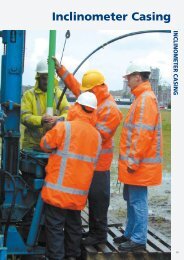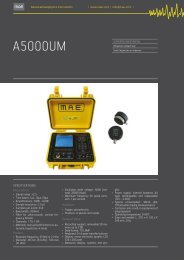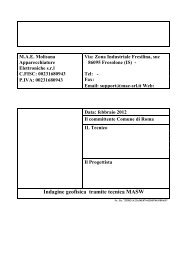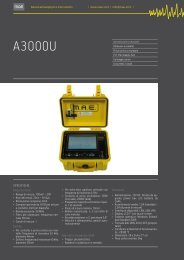Untitled
Untitled
Untitled
You also want an ePaper? Increase the reach of your titles
YUMPU automatically turns print PDFs into web optimized ePapers that Google loves.
› Mae 59<br />
› LOAD TESTS<br />
The load tests have the primary objective<br />
to compare the experimental<br />
arrows obtained during the testing<br />
phase and the theoretical arrows<br />
of the project, in order to evaluate<br />
the deformation profile of the element<br />
tested. The test loads used can<br />
be distributed (bricks, blocks or cement<br />
bags, water tanks) or similar<br />
concentrates (hydraulic jacks). The<br />
tests that use similar concentrated<br />
loads can be of pull or push test type.<br />
The result of the load tests and elastic<br />
behaviour of the structure is represented<br />
through load/shift graphs and<br />
hysteresis curves. The measurement<br />
of the shifts and deformations can be<br />
taken with manual systems, such as<br />
mechanical comparators or deflectometers<br />
or with automatic-electric<br />
systems, such as movement transducers<br />
(resistive, inductive, potenziometric).<br />
The use of these electric systems<br />
allows continuous, stable and<br />
precise readings that can be transmitted<br />
also far away from the relative<br />
testing area. Rapidity of execution, accuracy<br />
and safety make this system<br />
the most diffused one nowadays, in<br />
the test and trial sector.<br />
› MEASUREMENT OF THE HEAT TRANSMISSION IN GROUNDS<br />
The measurement method is based<br />
on the so called unstable sensor technique,<br />
that uses a probe (also called<br />
thermal needle), which mounts a heating<br />
wire and a temperature sensor. The<br />
probe is introduced in the ground. From<br />
its response when subject to a heating<br />
cycle for a few minutes, it is possible<br />
to calculate the thermal resistivity (or<br />
its opposite, the heat transmission).<br />
The principle of the measurement is<br />
based on a peculiar characteristic of<br />
a rectilinear heat course (the heating<br />
wire of the probe): after a short transitional<br />
period, the increase of the temperature<br />
depends only on the heating<br />
power and heat transmission of the<br />
medium. Once the first is known, the<br />
second can be calculated. The main<br />
applications of the technique consists<br />
in the testing of high voltage cables<br />
and heating ducts.









